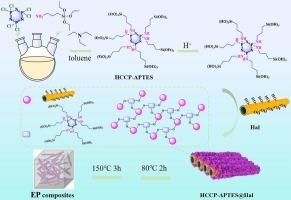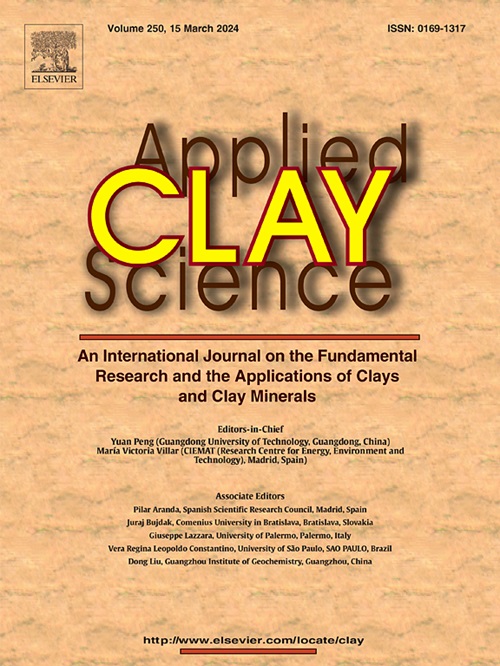膦腈衍生物改性哈洛石阻燃剂的合成及其对环氧树脂阻燃性和机械性能的同步改善
IF 5.3
2区 地球科学
Q2 CHEMISTRY, PHYSICAL
引用次数: 0
摘要
设计具有良好阻燃性和机械性能的阻燃环氧树脂(EP)一直是一项重要的研究课题。本文通过六氯环三磷腈(HCCP)和 3-氨基丙基三乙氧基硅烷(APTES)之间的亲核取代反应,合成了氨基官能化磷腈中间体(HCCP-APTES)。通过化学交联的方法,在哈洛来石(Hal)的外表面制备出了不同比例的哈洛来石基阻燃剂(HCCP-APTES@Hal)。将 Hal 和 HCCP-APTES@Hal 添加到 EP 中,研究它们对 EP 阻燃性能和机械性能的影响。当 HCCP-APTES.Hal 的质量比为 3:1 时,将阻燃剂(3HCCP-APTES@Hal)添加到 EP 中:Hal 的质量比为 3:1 时,在 EP 中的添加量为 6 wt%,LOI 值为 27.20 %。锥形量热试验(CCT)结果表明,与纯 EP 相比,峰值放热率(PHRR)和峰值产烟率(PSPR)分别降低了 36.84 % 和 52.08 %。HCCP-APTES 改性 Hal 很好地改善了与 EP 的界面相容性,从而提高了机械性能。这项研究为今后改性 Hal 和制备多功能 Hal 基阻燃剂提出了新的思路和策略。本文章由计算机程序翻译,如有差异,请以英文原文为准。

Synthesis of phosphonitrile derivative-modified halloysite flame retardants and their simultaneous enhancement of epoxy resins flame retardancy and mechanical properties
Design of flame retardant epoxy resins (EP) with good flame retardant and mechanical properties has been an important topic of research. In this paper, an amino-functionalized phosphonitrile intermediate (HCCP-APTES) was synthesized by nucleophilic substitution reaction between hexachlorocyclotriphosphonitrile (HCCP) and 3-aminopropyltriethoxysilane (APTES). Hal-based flame retardants (HCCP-APTES@Hal) with different ratios were prepared by chemically cross-linking them on the outer surface of halloysite (Hal). Hal and HCCP-APTES@Hal were added to EP to study their effects on the flame retardant and mechanical properties of EP. The flame retardant (3HCCP-APTES@Hal) when the mass ratio of HCCP-APTES: Hal was 3:1 was added to EP at 6 wt% and the LOI value was 27.20 %. And the cone calorimetry test (CCT) results showed that the peak heat release rate (PHRR) and peak smoke production rate (PSPR) decreased by 36.84 % and 52.08 %, respectively, compared with pure EP. HCCP-APTES-modified Hal well-improved the interfacial compatibility with EP, which led to the enhancement of mechanical properties. This study proposes new ideas and strategies for the modification of Hal and the preparation of multifunctional Hal-based flame retardants in the future.
求助全文
通过发布文献求助,成功后即可免费获取论文全文。
去求助
来源期刊

Applied Clay Science
地学-矿物学
CiteScore
10.30
自引率
10.70%
发文量
289
审稿时长
39 days
期刊介绍:
Applied Clay Science aims to be an international journal attracting high quality scientific papers on clays and clay minerals, including research papers, reviews, and technical notes. The journal covers typical subjects of Fundamental and Applied Clay Science such as:
• Synthesis and purification
• Structural, crystallographic and mineralogical properties of clays and clay minerals
• Thermal properties of clays and clay minerals
• Physico-chemical properties including i) surface and interface properties; ii) thermodynamic properties; iii) mechanical properties
• Interaction with water, with polar and apolar molecules
• Colloidal properties and rheology
• Adsorption, Intercalation, Ionic exchange
• Genesis and deposits of clay minerals
• Geology and geochemistry of clays
• Modification of clays and clay minerals properties by thermal and physical treatments
• Modification by chemical treatments with organic and inorganic molecules(organoclays, pillared clays)
• Modification by biological microorganisms. etc...
 求助内容:
求助内容: 应助结果提醒方式:
应助结果提醒方式:


